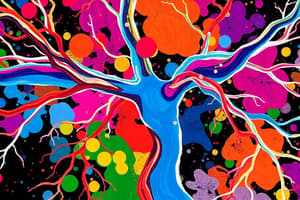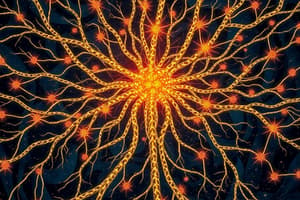Podcast
Questions and Answers
The nervous system is responsible for coordinating what two aspects of the body?
The nervous system is responsible for coordinating what two aspects of the body?
Actions and sensory information
What are the two main divisions of the nervous system?
What are the two main divisions of the nervous system?
- Somatic nervous system and Autonomic nervous system
- Central nervous system and Peripheral nervous system (correct)
- Sympathetic nervous system and Parasympathetic nervous system
What does the CNS consist of?
What does the CNS consist of?
Brain and spinal cord
What are the two main types of cells in the nervous system?
What are the two main types of cells in the nervous system?
What is the role of neuroglia in the nervous system?
What is the role of neuroglia in the nervous system?
What are three main types of connective tissue cells in the CNS?
What are three main types of connective tissue cells in the CNS?
What are the three parts of a neuron?
What are the three parts of a neuron?
What type of neuron causes muscle contractions and controls secretions from glands and organs?
What type of neuron causes muscle contractions and controls secretions from glands and organs?
What is the name of the fatty layer that insulates the axon of a motor neuron?
What is the name of the fatty layer that insulates the axon of a motor neuron?
What is the definition of a synapse?
What is the definition of a synapse?
What are the three structures that make up a synapse?
What are the three structures that make up a synapse?
What role do neurotransmitters play in a synapse?
What role do neurotransmitters play in a synapse?
What is an action potential?
What is an action potential?
At rest, a neuron's membrane is slightly positive on the outside. What is this state called?
At rest, a neuron's membrane is slightly positive on the outside. What is this state called?
What happens when a stimulus triggers the opening of Na+ channels in a neuron's plasma membrane?
What happens when a stimulus triggers the opening of Na+ channels in a neuron's plasma membrane?
The central nervous system controls most functions of the body and mind, including voluntary and involuntary movements.
The central nervous system controls most functions of the body and mind, including voluntary and involuntary movements.
What are the three parts of the brain stem?
What are the three parts of the brain stem?
Where does the pons lie?
Where does the pons lie?
What are the three meninges?
What are the three meninges?
What is the name of the fluid that surrounds the brain and spinal cord?
What is the name of the fluid that surrounds the brain and spinal cord?
What are the main functions of cerebrospinal fluid?
What are the main functions of cerebrospinal fluid?
The spinal cord has 36 segments in total.
The spinal cord has 36 segments in total.
How is the spinal cord protected?
How is the spinal cord protected?
Gray matter contains cell bodies, while white matter contains myelinated fibers.
Gray matter contains cell bodies, while white matter contains myelinated fibers.
What are the two types of nerves that branch out and connect to the peripheral nervous system at each segment of the spinal cord?
What are the two types of nerves that branch out and connect to the peripheral nervous system at each segment of the spinal cord?
What is a reflex arc?
What is a reflex arc?
Reflex arcs occur before the brain is aware of the response.
Reflex arcs occur before the brain is aware of the response.
What is the name of the lobe of the brain that is responsible for voluntary movements, personality, and speech?
What is the name of the lobe of the brain that is responsible for voluntary movements, personality, and speech?
What is the name of the lobe of the brain that is responsible for vision?
What is the name of the lobe of the brain that is responsible for vision?
What is the name of the lobe of the brain that is responsible for hearing, smell, and language input?
What is the name of the lobe of the brain that is responsible for hearing, smell, and language input?
Flashcards
What is the nervous system?
What is the nervous system?
The nervous system is the communication network of the body. It collects information from the environment, processes it, and initiates responses.
What is the CNS?
What is the CNS?
The central nervous system (CNS) is the command center of the nervous system, containing the brain and spinal cord.
What is the PNS?
What is the PNS?
The peripheral nervous system (PNS) is the network of nerves that connect the CNS to the rest of the body, like an intricate web of communication.
What are motor neurons?
What are motor neurons?
Signup and view all the flashcards
What are sensory neurons?
What are sensory neurons?
Signup and view all the flashcards
What is the somatic nervous system?
What is the somatic nervous system?
Signup and view all the flashcards
What is the autonomic nervous system?
What is the autonomic nervous system?
Signup and view all the flashcards
What is the sympathetic division?
What is the sympathetic division?
Signup and view all the flashcards
What is the parasympathetic division?
What is the parasympathetic division?
Signup and view all the flashcards
What are neurons?
What are neurons?
Signup and view all the flashcards
What are neuroglia?
What are neuroglia?
Signup and view all the flashcards
What is the cell body of a neuron?
What is the cell body of a neuron?
Signup and view all the flashcards
What are dendrites?
What are dendrites?
Signup and view all the flashcards
What is an axon?
What is an axon?
Signup and view all the flashcards
What are the characteristics of motor neurons?
What are the characteristics of motor neurons?
Signup and view all the flashcards
What are the characteristics of sensory neurons?
What are the characteristics of sensory neurons?
Signup and view all the flashcards
What are interneurons?
What are interneurons?
Signup and view all the flashcards
What are astrocytes?
What are astrocytes?
Signup and view all the flashcards
What are microglia?
What are microglia?
Signup and view all the flashcards
What are oligodendrocytes?
What are oligodendrocytes?
Signup and view all the flashcards
What are Schwann cells?
What are Schwann cells?
Signup and view all the flashcards
What is a synapse?
What is a synapse?
Signup and view all the flashcards
What are neurotransmitters?
What are neurotransmitters?
Signup and view all the flashcards
What are action potentials?
What are action potentials?
Signup and view all the flashcards
What is the brain?
What is the brain?
Signup and view all the flashcards
What is the spinal cord?
What is the spinal cord?
Signup and view all the flashcards
What is gray matter?
What is gray matter?
Signup and view all the flashcards
What is white matter?
What is white matter?
Signup and view all the flashcards
What are meninges?
What are meninges?
Signup and view all the flashcards
What is cerebrospinal fluid?
What is cerebrospinal fluid?
Signup and view all the flashcards
What are reflex arcs?
What are reflex arcs?
Signup and view all the flashcards
Study Notes
Nervous System Overview
- The nervous system is a complex network coordinating body actions and sensory information.
- It transmits signals between different parts of the body.
- It detects and responds to environmental changes.
Nervous System Divisions
- Central Nervous System (CNS):
- Comprises the brain and spinal cord.
- Processes information and initiates actions.
- Peripheral Nervous System (PNS):
- Network of nerves and neural tissues.
- Branches throughout the body.
- Transmits signals between the CNS and body.
- Consists of sensory and motor nerves.
Neurons
- Nerve cells that are the structural and functional units of the nervous system.
- Conduct impulses for communication.
- Consist of three parts:
- Cell body (main part):
- Dendrites (branching projections): Receive impulses to the cell body.
- Axons (elongated projection): Sends impulses away from the cell body.
Types of Neurons
-
Motor neurons:
- Cause muscle contractions.
- Control gland secretions.
-
Sensory neurons:
- Do not have true dendrites.
- Connected to sensory receptors.
- Transmit impulses to the CNS.
-
Interneurons:
- Found entirely within the CNS.
- Receive impulses from sensory neurons.
- Transmit signals to motor neurons.
Neuroglia
- Supporting cells providing structural and functional support to nervous tissue in the CNS.
- Types:
- Astrocytes: Anchor blood vessels to neurons.
- Microglia: Move in inflamed brain tissue, carrying out phagocytosis.
- Oligodendrocytes: Form myelin sheaths in the CNS. (Schwann cells form myelin sheaths in the PNS).
Nerve Fibers
- Bundles of nerve fibers forming nerves.
- Schwann cells insulate axons in the PNS.
Synapses
- Junctions where impulses are transmitted from one neuron to another (postsynaptic neuron).
- Made up of synaptic knob, synaptic cleft, and plasma membrane.
Neurotransmitters (Examples)
- Acetylcholine: Activates muscles.
- Dopamine: Control of movement.
- Epinephrine: Stress response.
- Serotonin: Mood, sleep.
- Endorphins: Mood, pain reduction.
- Nitric Oxide: Memory storage.
Action Potential (Nerve Impulses)
- Self-propagating wave of electrical disturbance along a neuron's membrane.
Mechanism of Action Potential
-
At rest, the neuron's membrane is slightly positive outside due to sodium ion excess.
-
A stimulus triggers sodium channels opening in the plasma membrane.
-
Inward movement of sodium depolarizes the membrane inside the cell locally making the inside more positive than the outside.
-
Depolarization triggers the next section of membrane to depolarize propagating an electrical disturbance along the membrane.
Divisions Of The Brain
- Brainstem:
- Medulla oblongata, pons, midbrain.
- Regulates vital functions such as breathing and heart rate.
- Cerebellum:
- Coordinates voluntary and involuntary movements.
- Maintains body posture.
Brain Lobes
- Frontal lobe: Motor activity, personality, and speech.
- Parietal lobe: Language, temperature, pressure, and touch interpretation.
- Temporal lobe: Hearing, smell, and language interpretation.
- Occipital lobe: Vision.
Spinal Cord
- Protected by the vertebrae.
- Gray matter: Contains cell bodies.
- White matter: Contains myelinated fibers.
- Has 31 segments (8 cervical, 12 thoracic, 5 lumbar, 5 sacral, 1 coccygeal).
- Pairs of sensory and motor nerves branch out at each segment.
Cerebrospinal Fluid (CSF)
- Cushions the brain and spinal cord.
- Protects them from shocks.
- Maintains a level around 1/2 to 2/3 cup.
- Removes waste products and supplies nutrients to nervous system tissue. Important for proper brain function.
Reflex Arcs (Reflex Activity)
- Nerve impulses from receptors to effectors via neuron pathways (reflex arcs).
- Simplest reflex arc: Two-neuron arc: Sensory neurons synapse in the spinal cord with motor neurons.
- Sensory neurons receive stimulus from sensory receptors.
- Association or interneurons connect them to motor neurons.
- Motor neurons transmit signals to effectors (like muscles or glands) causing their response.
- Response happens before the brain is aware.
Studying That Suits You
Use AI to generate personalized quizzes and flashcards to suit your learning preferences.



